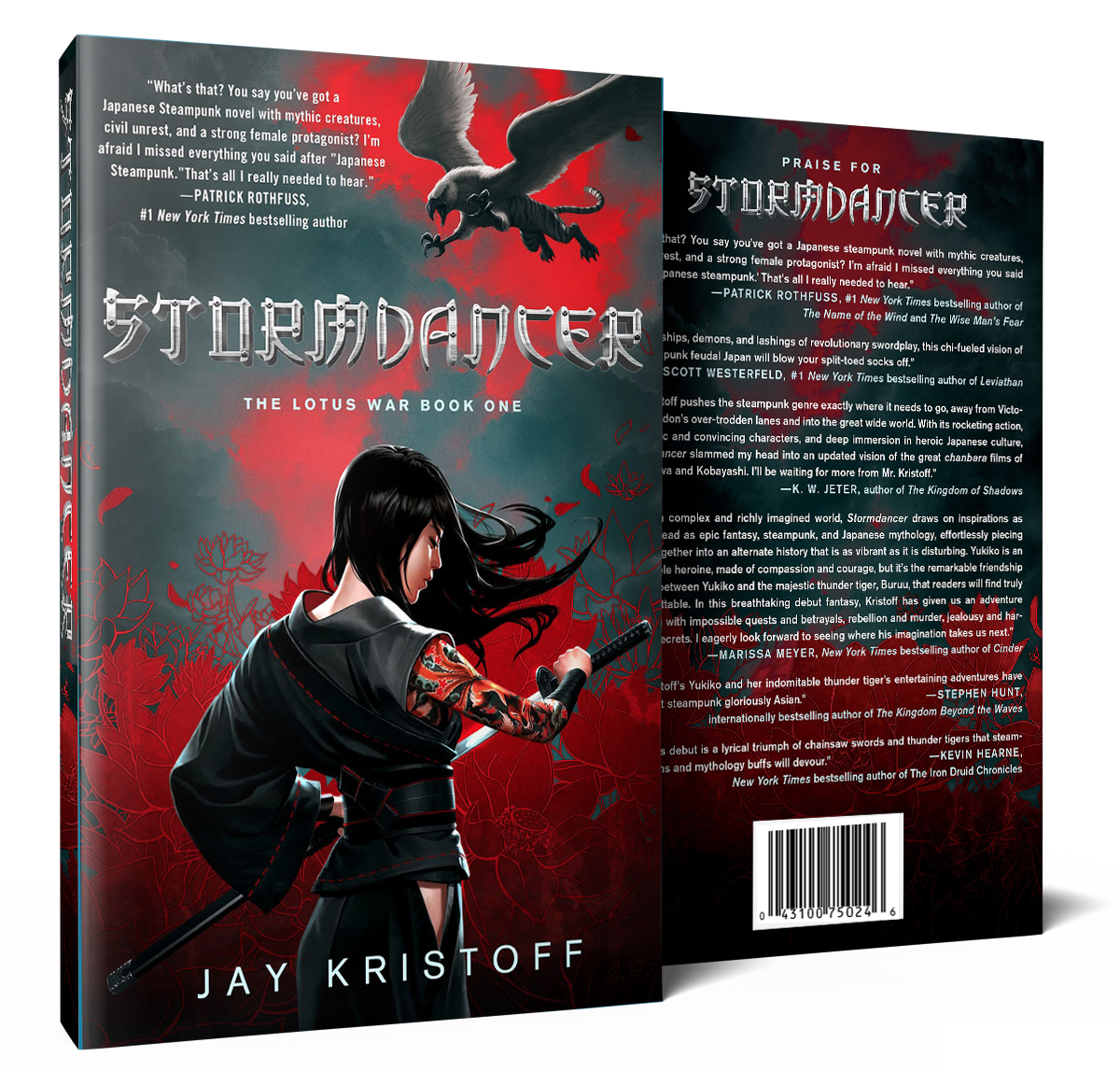
When the word “steampunk” comes to mind, most people immediately think of airships from video games like Final Fantasy or K.W. Jeter’s Morlock Night and Scott Westerfeld’s Leviathan. Often seen in literature, the steampunk subgenre often takes place in Victorian era London, much like Morlock Night. Jay Kristoff’s Stormdancer, is one of the more unique exceptions. The story itself takes place in a fictional location called the Shima Isles and the story blends Japanese mythology with steampunk technology easily.
There are four clans in the Shima Isles: tora (tiger), kitsune (fox), ryu (dragon) and fushicho (phoenix). The Seii Taishogun and emperor of the Shima Isles, Yoroitomo-no-Miya of the Tora clan, took the throne at the age of thirteen when his father passed away. One day, Yoroitomo-no-Miya had a dream of riding an arashitora, a thunder tiger, into battle and ending the rebellion against his empire. He then issues an order to capture an arashitora, but there is one problem.
Arashitora do not exist anymore.
Nevertheless, Yoroitomo-no-Miya demands an arashitora because he is Hachiman’s chosen and threatens death if anyone fails.
As I said before, Stormdancer blends Japanese mythology into its story, using the Gods and Goddesses of this particular mythology, is one example. Hachiman is the god of war and is the head figure of the tora clan. Other deities like the Sun Goddess Amaterasu, God of Storms Susano-o, God of Creation Izanagi no Mikoto, Goddess of Creation and Death Izanami, God of Lightning Raijin, God of the Moon Tsukiyomi, and the Judge of the Dead, Enma-o, are also mentioned within the story.
Since Yoroitomo-no-Miya believes he was chosen by the God of War to rule over the Shima Isles within the first chapter, Kristoff immediately sets up the main villain and his motive.
Kristoff then introduces the protagonist of the story, Yukiko of the Kitsune clan.
A warrior woman in the making, she presents herself as brash, blunt, caring, smart, yet also blinded by a grudge she holds against her father, a famous Oni Hunter named Masaru, who smokes lotus to escape reality and gambles much of their money instead of using it for necessities. While on an airship powered by lotus, they arrive into Kigen City, south of the Shima Isles, to meet with their taishogun and begin their quest to hunt down an arashitora. A particular scene which establishes the world well is when they enter Kigen City, which is covered in a dense fog that is harmful to breathe, and citizens wear bandanas over their mouths to filter out the smog.
Kristoff introduces pollution into the story, since red lotus is considered a fossil fuel and it is constantly grown and cultivated to make the economy flourish to power up airships and factories. Due to the cultivation of red lotus, chemicals are spread out into the air, nearly impossible to breathe and see through, while the land becomes unable to grow crops. If farmers do not grow this cash crop or leave their plantation to the government, the taishogun’s army burns down the plantation, effectively killing citizens. This becomes an important plot point later down the line.
Slave labor is the second theme, since peasant children and women are sent to the factories to work without sleep until they die. The corpses are then burned and more slaves are brought in to replace the previous workers. These slave drivers are figures dressed in mechanical suits whom are immune to the red lotus’s harmful effects and have political connections with the taishogun. Not only do they serve as the slave drivers, they engineer lotus powered technology, which are used as weaponry, and eradicate people who are born with special abilities.
Yukiko is one of those people.
Yukiko can speak telepathically with animals and understand them. Yukiko is also able to feel the same emotions and pain as the animal she is connected to. While sailing across the sky, a thunderstorm emerges and rain pelts against the airship.
Lightning cracks across the dark clouds and a thunderous roar is heard over the downpour.
An arashitora, a half eagle half tiger, flies across the sky and its roar causes the ship to quake. Masaru, along with his companions Akihito and Kasumi, come together to capture the arashitora, a difficult task which results in the airship becoming severely damaged and falls towards the Iishi Mountains to the north.
What happens next? I would tell you, but that’d just spoil the fun.
Plot aside, the characters themselves are quite a spectacle. Yukiko, who starts off as this stand offish and stubborn girl, becomes a mature and focused woman and an inspirational figure at the end of the book. Masaru’s backstory is explained, showing him as a veteran hunter, a normal person with memories he cannot bear to relive and as a wise character who passes down an important life lessons to Yukiko, even though she refuses to listen initially. Yoroitomo-no-Miya is an excellent villain, he is a man who flaunts his power with a chilling air, carries himself with authority and has a threatening attitude that intimidates his peers. Unexpected twists and turns will hook you into this fantastical world and the ending will leave you wanting to know what happens next.
That being said, I must give Stormdancer the recommendation to Buy It. Kristoff’s novel is a breath of fresh air with its blend of Japanese mythology, fleshed out and relatable characters, the execution and implementation of steampunk technology is done well and including issues which relates to the real world makes this story feel more alive.
For alternate recommendations, I must point you towards Scott Westerfeld’s Leviathan, as it mixes steampunk technology into a plot centered on World War One and Morlock Night by K.W. Jeter, the book which began the steampunk subgenre with its Victorian London world setting and time traveling which connects to H.G. Well’s novel, The Time Machine.
